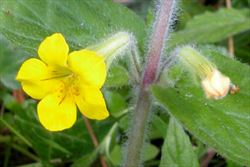Click on images to enlarge

close-up of tubular flower and hairy stem (Photo: Greg Jordan)

paired leaves and flowers (Photo: Greg Jordan)

habit (Photo: Jackie Miles)
Scientific Name
Erythranthe moschata (Douglas ex Lindl.) G.L.NesomSynonyms
Mimulus moschatus Douglas ex Lindl.Family
Scrophulariaceae
Common Names
monkey musk, musk flower, musk mimulus, musk monkey flower, musk monkey-flower, musk monkeyflower, muskflower, musk-scented monkey-flower
Origin
Native to Canada and northern and western USA (i.e. Connecticut, Massachusetts, Michigan, New Hampshire, New Jersey, New York, Pennsylvania, Vermont, West Virginia, Colorado, Idaho, Montana, Oregon, Washington, Wyoming, California, Nevada and Utah).
Naturalised Distribution
Naturalised in many parts of south-eastern Australia (i.e. eastern New South Wales, the ACT, Victoria, Tasmania and south-eastern South Australia). Also naturalised overseas in Chile and Europe.
Notes
Musk monkey-flower (Mimulus moschatus) is regarded as an environmental weed in Victoria. This species grows in moist sites in grasslands, in gullies, in swamps and along streams.
It is seen as a potential threat to one or more vegetation formations in Victoria (e.g. swampy riparian woodlands and forest creekline sedge swamps), and is of particular concern in wetlands in highland regions (i.e. montane bogs). These habitats are the home of the threatened southern corroboree frog (Pseudophryne corroboree), and some bogs in this region are already being invaded by musk monkey-flower (Mimulus moschatus). It is thought to be the most threatening weed to this frog's habitat, as it grows well in the sphagnum moss common in these habitats and may form quite large patches of vegetation.
In New South Wales, musk monkey-flower (Mimulus moschatus) is mainly found south from the Orange district and in the Blue Mountains area. It has also been recorded from conservation areas in southern New South Wales (i.e. Kosciuszko National Park) and south-eastern South Australia (i.e. Cleland Conservation Park).

